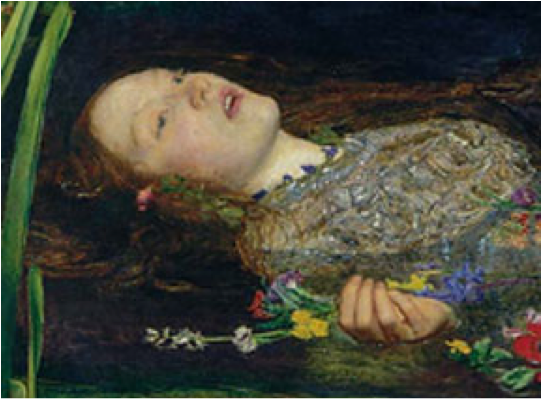Ophelia, Shards and Suicides October 30, 2015
Author: Beach Combing | in : Medieval, Modern , trackbackIn Hamlet a priest says of the dead Ophelia as she is being brought to her burial (5,1):
She should in ground unsanctified have lodged
Till the last trumpet: for charitable prayers,
Shards, flints and pebbles should be thrown on her:
But what is this about ‘shards, flints and pebbles’? The Auden Shakespeare has no explanation beyond the syntactical. Martin Puhvel associated it with a suicide burial in English Language Notes in March 1978: and there is the possibility that Ophelia, who had been driven mad by Hamlet and his actions, had actually thrown herself into the river deliberately. Can this strange custom be bourne out by medieval and early modern archaeaology? Here is an interesting report from Bed Times, 17 July 1931, 10
A grim reminder of mediaeval superstition was brought to light by the gravedigger at Oakley, when he was preparing for an interment recently. Within recent years (writes the Rev. P. G. Langdon, F.b.A.) a portion of field, unconsecrated ground until then, called Parsonage Close, on the north side of Oakley churchyard, was added to the churchyard for burial purposes. Last month, when digging a grave, the sexton was surprised to come upon the skeleton of a young woman, which was unearthed at a depth of 4ft. 6 in. The body was uncoffined and was lying on a layer of small pieces of thin slabs of local limestone. It was covered with similar pieces, with pebbles, and with scores of fragments of broken shards. These latter are fragments of pots of every description, and by their runs, bases, and texture proved to be portions of mediaeval pots, apparently of the 15th century. The theory, therefore, is that the burial brought to light was that of a girl of perhaps 17 or 18 – one wisdom tooth had not erupted – who had committed suicide. This is suggested by the fact that the burial had not taken place in the original churchyard, but the glebe land immediately to the north of it. Land immediately adjoining the north side of a churchyard was often regarded by country folk as a sort of ‘devil’s half-acre’ in contrast to ‘God’s acre’.
Perhaps throwing shards on the grave was just the equivalent of throwing earth on graves? The placing of the body outside the cemetery is a far more difficult to explain unless the dating is completely off: though how many vicars can accurately date medieval pottery?
Any thoughts or help? Drbeachcombing AT yahoo DOT com
15 Nov 2015, Leif (an old friend of the blog) writes in:
This from Issac Watts A Defense Against the Temptation to Self-Murther [London: Printed for J. Clark, R. Hett, E. Matthews, and R. Ford, 1726.]
“…And as the church denies them Christian burial, so the civil government did heretofore appoint that they should be put into the earth with the utmost contempt; and this was generally done in some publick cross-way, that the shame and infamy might be made known to every passenger; and that this infamy might be lasting, they were ordained to have a stake driven through their dead bodies which was not to be removed. ‘Tis pity this practice has been omitted of late years by the too favourable sentence of their neighbors on the jury, who generally pronounce them distracted: And thus they are excused from this publick mark of abhorrence. ”
Either Watts is disingenuous or writes in a time when suicide burial customs were remembered, but the underlying reasons forgotten. Today, Bram Stoker fans would instantly recognize the stake as a charm to prevent a corpse from “walking again”. Shakespeare’s “shards, flints and pebbles” are almost certainly the same– a revenant could be pinned, weighed down, or both. The question is whether Shakespeare’s audience would have understood the reasoning behind the custom.



